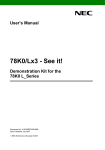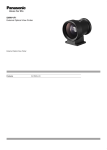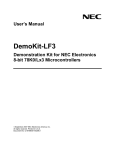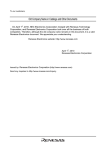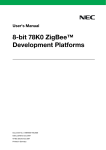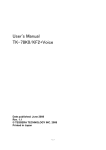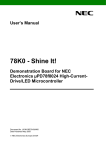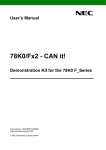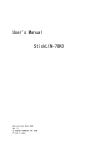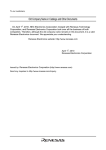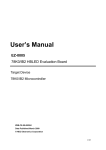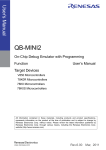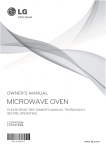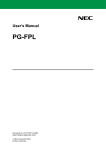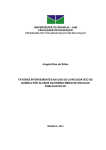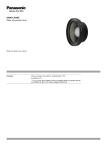Download User`s Manual 78K0/Lx3
Transcript
User’s Manual 78K0/Lx3 - See it! Demonstration Kit for the 78K0 L_Series Document No. U18759EE2V0UM00 Date Published July 2007 © NEC Electronics (Europe) GmbH 78K0/Lx3 - See it! ・ The information in this document is current as of date of its publication. The information is subject to change without notice. For actual design-in, refer to the latest publications of NEC Electronics data sheets or data books, etc., for the most up-to-date specifications of NEC Electronics products. Not all products and/or types are available in every country. Please check with an NEC sales representative for availability and additional information. ・ No part of this document may be copied or reproduced in any form or by any means without prior written consent of NEC Electronics. NEC Electronics assumes no responsibility for any errors that may appear in this document. ・ NEC Electronics does not assume any liability for infringement of patents, copyrights or other intellectual property rights of third parties by or arising from the use of NEC Electronics products listed in this document or any other liability arising from the use of such NEC Electronics products. No license, express, implied or otherwise, is granted under any patents, copyrights or other intellectual property rights of NEC Electronics or others. ・ Descriptions of circuits, software and other related information in this document are provided for illustrative purposes in semiconductor product operation and application examples. The incorporation of these circuits, software and information in the design of customer's equipment shall be done under the full responsibility of customer. NEC Electronics no responsibility for any losses incurred by customers or third parties arising from the use of these circuits, software and information. ・ While NEC Electronics endeavors to enhance the quality, reliability and safety of NEC Electronics products, customers agree and acknowledge that the possibility of defects thereof cannot be eliminated entirely. To minimize risks of damage to property or injury (including death) to persons arising from defects in NEC Electronics products, customers must incorporate sufficient safety measures in their design, such as redundancy, fire-containment and anti-failure features. ・ NEC Electronics products are classified into the following three quality grades: “Standard”, “Special” and “Specific”. The "Specific" quality grade applies only to NEC Electronics products developed based on a customerdesignated “quality assurance program” for a specific application. The recommended applications of NEC Electronics product depend on its quality grade, as indicated below. Customers must check the quality grade of each NEC Electronics product before using it in a particular application. "Standard": Computers, office equipment, communications equipment, test and measurement equipment, audio and visual equipment, home electronic appliances, machine tools, personal electronic equipment and industrial robots. "Special": Transportation equipment (automobiles, trains, ships, etc.), traffic control systems, antidisaster systems, anti-crime systems, safety equipment and medical equipment (not specifically designed for life support). "Specific": Aircraft, aerospace equipment, submersible repeaters, nuclear reactor control systems, life support systems and medical equipment for life support, etc. The quality grade of NEC Electronics products is “Standard” unless otherwise expressly specified in NEC Electronics data sheets or data books, etc. If customers wish to use NEC Electronics products in applications not intended by NEC Electronics, they must contact NEC Electronics sales representative in advance to determine NEC Electronics 's willingness to support a given application. Notes: 1." NEC Electronics" as used in this statement means NEC Electronics Corporation and also includes its majority-owned subsidiaries. 2. " NEC Electronics products" means any product developed or manufactured by or for NEC Electronics (as defined above). User’s Manual U18759EE2V0UM00 2 78K0/Lx3 - See it! CAUTION This is a Test- and Measurement equipment with possibility to be significantly altered by user through hardware enhancements/modifications and/or test or application software. Thus, with respect to Council Directive 89/336/EEC (Directive on compliance with the EMC protection requirements), this equipment has no autonomous function. Consequently this equipment is not marked by the CE-symbol. EEDT-ST-005-10 CAUTION This equipment should be handled like a CMOS semiconductor device. The user must take all precautions to avoid build-up of static electricity while working with this equipment. All test and measurement tool including the workbench must be grounded. The user/operator must be grounded using the wrist strap. The connectors and/or device pins should not be touched with bare hands. EEDT-ST-004-10 Redemption of Waste Electrical and Electronic Equipment (WEEE) in accordance with legal regulations applicable in the European Union only: This equipment (including all accessories) is not intended for household use. After use the equipment cannot be disposed of as household waste. NEC Electronics (Europe) GmbH offers to take back the equipment. All you need to do is register at www.eu.necel.com/weee. User’s Manual U18759EE2V0UM00 3 78K0/Lx3 - See it! Regional Information Some information contained in this document may vary from country to country. Before using any NEC product in your application, please contact the NEC office in your country to obtain a list of authorized representatives and distributors. They will verify: • • • • • • Device availability Ordering information Product release schedule Availability of related technical literature Development environment specifications (for example, specifications for third-party tools and components, host computers, power plugs, AC supply voltages, and so forth) Network requirements In addition, trademarks, registered trademarks, export restrictions, and otherlegal issues may also vary from country to country. NEC Electronics Inc. (U.S.) Santa Clara, California Tel: 408-588-6000 800-366-9782 Fax: 408-588-6130 800-729-9288 NEC Electronics Hong Kong Ltd. Hong Kong Tel: 2886-9318 Fax: 2886-9022/9044 NEC Electronics (Europe) GmbH Duesseldorf, Germany Tel: 0211-65 03 0 Fax: 0211-65 03 1327 NEC Electronics Hong Kong Ltd. Seoul Branch Seoul, Korea Tel: 02-528-0303 Fax: 02-528-4411 Sucursal en España Madrid, Spain Tel: 091- 504 27 87 Fax: 091- 504 28 60 NEC Electronics Singapore Pte. Ltd. Singapore Tel: 65-6253-8311 Fax: 65-6250-3583 Succursale Française Vélizy-Villacoublay, France Tel: 01-30-67 58 00 Fax: 01-30-67 58 99 NEC Electronics Taiwan Ltd. Taipei, Taiwan Tel: 02-2719-2377 Fax: 02-2719-5951 Filiale Italiana Milano, Italy Tel: 02-66 75 41 Fax: 02-66 75 42 99 NEC do Brasil S.A. Electron Devices Division Guarulhos, Brasil Tel: 55-11-6465-6810 Fax: 55-11-6465-6829 Branch The Netherlands Eindhoven, The Netherlands Tel: 040-244 58 45 Fax: 040-244 45 80 Branch Sweden Taeby, Sweden Tel: 08-63 80 820 Fax: 08-63 80 388 United Kingdom Branch Milton Keynes, UK Tel: 01908-691-133 Fax: 01908-670-290 User’s Manual U18759EE2V0UM00 4 78K0/Lx3 - See it! Revision History Date 21-06-2007 20-07-2007 Revision V1.00 V2.00 Chapter --5, 7, 8, 9 Description First release Changed description from FPL3 to WriteEZ3 FLASH programming software User’s Manual U18759EE2V0UM00 5 78K0/Lx3 - See it! Table of Contents 1. Introduction ........................................................................................................................10 1.1 1.2 1.3 1.4 Main features of 78K0/Lx3 - See it!................................................................................................ 10 System requirements...................................................................................................................... 12 Package contents............................................................................................................................ 12 Trademarks ...................................................................................................................................... 12 2. 78K0/Lx3 - See it! system configuration..........................................................................13 2.1 2.2 2.3 78K0/Lx3 - See it! ............................................................................................................................ 13 Host computer ................................................................................................................................. 13 Power supply via USB interface .................................................................................................... 13 3. 78K0/Lx3 - See it! components.........................................................................................14 3.1 3.1.1 3.1.2 3.1.3 3.2 3.3 3.4 3.5 3.6 3.7 3.8 3.9 3.10 3.11 3.12 3.13 3.14 3.15 3.16 3.17 3.18 3.19 Configuration switches SW1 / SW2............................................................................................... 15 On-Board Debug Mode (TK-78 debugging)................................................................................... 15 FPL3(WriteEZ3) Mode (FLASH programming mode).................................................................... 15 QB-MINI2 Mode (OCD debugging / Normal execution mode) ...................................................... 15 RESET button, SW4 ........................................................................................................................ 16 Navigation switch, SW3.................................................................................................................. 16 External A/D measurement inputs, connector J1........................................................................ 17 External A/D measurement input, connector J2.......................................................................... 17 IDD measurement, connector J4 ................................................................................................... 17 External power supply input, connector J5 ................................................................................. 17 External main oscillator, Y1 ........................................................................................................... 17 QB-MINI2 connector, OCD1 ........................................................................................................... 18 USB interface connector, USB1 .................................................................................................. 19 LCD1, 224 segment LCD panel .................................................................................................... 20 External LCD resistors, RR1 – RR5............................................................................................. 22 Temperature sensor, U2 ............................................................................................................... 22 IR receiver module, U4 ................................................................................................................. 22 Buzzer, BUZ1 ................................................................................................................................. 22 Power LED, LED1 .......................................................................................................................... 22 Connectors T1 – T13 and wrap field ........................................................................................... 23 Soldering bridges.......................................................................................................................... 24 78K0/LF3 memory map................................................................................................................. 25 4. On-Chip debugging ...........................................................................................................26 4.1 4.2 OCD via TK-78 debug function ...................................................................................................... 26 OCD via QB-MINI2 emulator........................................................................................................... 27 5. 78K0/Lx3 - See it! installation and operation ..................................................................28 5.1 Getting started................................................................................................................................. 28 5.1.1 CD-ROM contents.......................................................................................................................... 28 6. Hardware installation.........................................................................................................29 7. Software installation..........................................................................................................29 User’s Manual U18759EE2V0UM00 6 78K0/Lx3 - See it! 7.1 7.2 7.3 7.4 7.4.1 7.4.2 7.4.3 7.5 7.6 8. IAR Systems Embedded Workbench for 78K installation .......................................................... 29 WriteEZ3 FLASH programming GUI installation.......................................................................... 29 Sample program installation.......................................................................................................... 29 USB Driver Installation ................................................................................................................... 30 Installation on Windows 98SE/Me ................................................................................................. 30 Installation on Windows 2000 ........................................................................................................ 32 Installation on Windows XP............................................................................................................ 38 Confirmation of USB Driver Installation ....................................................................................... 43 Driver deinstallation........................................................................................................................ 44 WriteEZ3 FLASH programming software ........................................................................46 8.1 8.2 8.3 8.4 8.4.1 8.4.2 8.4.3 8.4.4 8.5 Introduction ..................................................................................................................................... 46 Starting up the GUI Software ......................................................................................................... 46 Toolbar ............................................................................................................................................. 47 Menu Bar .......................................................................................................................................... 48 [File] menu...................................................................................................................................... 48 [Device] menu ................................................................................................................................ 49 [View] menu.................................................................................................................................... 58 [Help] menu .................................................................................................................................... 59 Programmer Parameter Window ................................................................................................... 60 9. How to use WriteEZ3 FLASH programming software ....................................................61 (1) (2) (3) (4) (5) (6) (7) (8) (9) (10) Installing the WriteEZ3 GUI software ................................................................................................ 61 Installing the driver............................................................................................................................. 61 Installing the parameter file................................................................................................................ 61 Connecting and starting..................................................................................................................... 62 Setting the programming environment .............................................................................................. 63 Selecting a user program .................................................................................................................. 66 [Autoprocedure(EPV)] command execution ...................................................................................... 67 Terminating the GUI .......................................................................................................................... 67 Execute the “VOLTMETER” application ............................................................................................ 67 Restarting the GUI ........................................................................................................................... 67 10. TROUBLESHOOTING ......................................................................................................68 11. IAR sample session .........................................................................................................70 12. Sample Projects ...............................................................................................................77 12.1 12.2 12.3 12.4 12.5 12.6 Buzzer sample ............................................................................................................................... 78 KitchenTimer sample.................................................................................................................... 78 RealTimeClock sample ................................................................................................................. 78 RemoteControl sample................................................................................................................. 78 Temperature sample ..................................................................................................................... 78 Voltmeter sample .......................................................................................................................... 78 13. Cables ...............................................................................................................................79 13.1 USB interface cable (Mini-B type) ............................................................................................... 79 User’s Manual U18759EE2V0UM00 7 78K0/Lx3 - See it! 14. Schematics .......................................................................................................................80 List of Figures Figure 1: 78K0/Lx3 - See it! system configuration ......................................................................................13 Figure 2: 78K0/Lx3 - See it! board connectors and switches, top view ......................................................14 Figure 3: Connector USB1, USB Mini-B Type Host Connector Pin Configuration .....................................19 Figure 4: LCD outline...................................................................................................................................20 Figure 5: Connectors T1 – T13 and wrap field............................................................................................23 Figure 6: 78K0/LF3 memory map................................................................................................................25 Figure 7: On-Chip Debugging .....................................................................................................................26 Figure 8: Add New Hardware Wizard (Windows 98SE)..............................................................................30 Figure 9: Search Method (Windows 98SE).................................................................................................30 Figure 10: Search Location Specification (Windows 98SE)........................................................................31 Figure 11: Checking Driver to Be Installed (Windows 98SE)......................................................................31 Figure 12: Installation Completion (Windows 98SE)...................................................................................32 Figure 13: Found New Hardware Wizard 1 (Windows 2000)......................................................................32 Figure 14: Search Method 1 (Windows 2000).............................................................................................33 Figure 15: Driver File Location 1 (Windows 2000) ......................................................................................33 Figure 16: Address Specification 1 (Windows 2000) ..................................................................................34 Figure 17: Driver File Search 1 (Windows 2000) ........................................................................................34 Figure 18: USB Driver Installation Completion 1 (Windows 2000) .............................................................35 Figure 19: Found New Hardware Wizard 2 (Windows 2000)......................................................................35 Figure 20: Search Method 2 (Windows 2000).............................................................................................36 Figure 21: Driver File Location 2 (Windows 2000) ......................................................................................36 Figure 22: Address Specification 2 (Windows 2000) ..................................................................................37 Figure 23: Driver File Search 2 (Windows 2000) ........................................................................................37 Figure 24: USB Driver Installation Completion 2 (Windows 2000) .............................................................38 Figure 25: Found New Hardware Wizard 1 (Windows XP).........................................................................38 Figure 26: Search Location Specification 3 (Windows XP).........................................................................39 Figure 27: Windows XP Logo Testing 3 (Windows XP) ..............................................................................39 Figure 28: USB Driver Installation Completion 1 (Windows XP).................................................................40 Figure 29: Found New Hardware Wizard 2 (Windows XP).........................................................................40 Figure 30: Search Location Specification 2 (Windows XP).........................................................................41 Figure 31: Windows XP Logo Testing 2 (Windows XP) ..............................................................................41 Figure 32: USB Serial Port2 Driver Installation Completion (Windows XP)................................................42 Figure 33: Device Manager .........................................................................................................................43 Figure 34: Driver Uninstallation ...................................................................................................................44 Figure 35: Driver Uninstaller........................................................................................................................44 Figure 36: Completion of Driver Uninstallation............................................................................................45 Figure 37: GUI Software Main Window .......................................................................................................46 Figure 38: Toolbar Buttons ..........................................................................................................................47 Figure 39: [File] Menu..................................................................................................................................48 Figure 40: HEX File Selection Window .......................................................................................................48 Figure 41: [Device] Menu ............................................................................................................................49 Figure 42: Device Setup Window - Standard ..............................................................................................51 Figure 43: Device Setup Window - Parameter File Selection .....................................................................52 Figure 44: Parameter File Selection Window..............................................................................................52 Figure 45: Device Setup Window – Host connection ..................................................................................53 Figure 46: Device Setup Window - Supply Oscillator Selection..................................................................53 Figure 47: Device Setup Window - Operation Mode...................................................................................54 Figure 48: Device Setup Window – Target Reset Message .......................................................................54 Figure 49: Device Setup Window - Advance...............................................................................................55 Figure 50: Device Setup Window - Command options ...............................................................................55 Figure 51: Device Setup Window – Security flag settings ..........................................................................56 Figure 52: Device Setup Window – Disable Chip Erase.............................................................................57 Figure 53: Device Setup Window – Disable Boot Cluster Reprogramming warning ..................................57 User’s Manual U18759EE2V0UM00 8 78K0/Lx3 - See it! Figure 54: [View] Menu................................................................................................................................58 Figure 55: [Help] Menu ................................................................................................................................59 Figure 56: About WriteEZ3 Window ............................................................................................................59 Figure 57: Programmer Parameter Window ...............................................................................................60 Figure 58: GUI Software Startup Screen.....................................................................................................63 Figure 59: <Standard Device Setup> Dialog Box .......................................................................................63 Figure 60: Parameter File Selection............................................................................................................64 Figure 61: Port Selection .............................................................................................................................64 Figure 62: <Standard Device Setup> Dialog Box after Setting...................................................................65 Figure 63: <Advance Device Setup> Dialog Box ........................................................................................65 Figure 64: Completion of Parameter Setting ...............................................................................................66 Figure 65: After Downloading......................................................................................................................66 Figure 66: After EPV Execution...................................................................................................................67 Figure 67: IAR Embedded Workbench .......................................................................................................71 Figure 68: IAR project workspace ...............................................................................................................72 Figure 69: IAR debugger options 1/2 ..........................................................................................................72 Figure 70: IAR debugger options 2/2 ..........................................................................................................73 Figure 71: IAR Linker options......................................................................................................................73 Figure 72: TK-78 hardware setup menu .....................................................................................................74 Figure 73: IAR project download .................................................................................................................75 Figure 74: IAR C-SPY debugger .................................................................................................................76 Figure 75: USB interface cable (Mini-B type)..............................................................................................79 Figure 76: 78K0/Lx3 - See it! schematics 1/2 .............................................................................................80 Figure 77: 78K0/Lx3 - See it! schematics 2/2 .............................................................................................81 List of Tables Table 1: Operation mode selection SW1 / SW2..........................................................................................15 Table 2: Navigation switch SW3..................................................................................................................16 Table 3: External A/D measurement inputs, connector J1..........................................................................17 Table 4: External A/D measurement input, connector J2 ...........................................................................17 Table 5: External power supply input, J3 ....................................................................................................17 Table 6: QB-MINI2 connector OCD1...........................................................................................................18 Table 7: Configuration of SW1 and SW2 when using QB-MINI2................................................................18 Table 8: Pin Configuration of Connector USB1...........................................................................................19 Table 9: LCD driver specification ................................................................................................................20 Table 10: LCD segment assignment ...........................................................................................................21 Table 11: Connectors T1 – T13...................................................................................................................23 Table 12: Setting of soldering bridges A1 – A8, V7 ....................................................................................24 Table 13: Setting of soldering bridges V1 – V6, V8 – V11 ..........................................................................24 Table 14: Configuration for TK-78 debugging .............................................................................................26 Table 15: Configuration for QB-MINI2 debugging.......................................................................................27 Table 16: 78K0/Lx3 - See it! CD-ROM directory structure..........................................................................28 Table 17: Example directory structure ........................................................................................................77 User’s Manual U18759EE2V0UM00 9 78K0/Lx3 - See it! 1. Introduction 78K0/Lx3 - See it! is a demonstration kit for the 78K0 L_Series 8-bit microcontrollers with integrated LCD controller. It supports On-Board debugging, FLASH programming and real time execution of application programs based on the 78K0/LF3 microcontroller. The board is prepared to be connected to user hardware parts such as digital I/O or analogue signals. 1.1 Main features of 78K0/Lx3 - See it! • Easy to use device demonstration capabilities 78K0/Lx3 - See it! contains elements to easily demonstrate simple I/O-functions, i.e. navigator switch, 224 segment LCD panel, temperature sensor, IR receiver module, I/O lines, UART serial interface etc. • TK-78 debugging The 78K0/Lx3 – See it! supports an On-Board debug function by using the IAR C-SPY debugger and the UART / USB interface without a need of additional debug hardware. It allows FLASH programming and supports standard debug functions i.e. code execution, single stepping, software breakpoints, memory manipulation etc. • OCD debugging The 78K0/Lx3 – See it! is prepared to be equipped with a 10-pin connector in order to connect the QB-MINI2 On-Chip debug emulator to use the On-Chip debug function of the 78K0/LF3 device. Please note, the QB-MINI2 is separate product from NEC and it is not included in this starterkit package. • Flexible power supply The 78K0/Lx3 - See it! supports a flexible configuration of it’s power supply. The board can be powered by the USB interface, the QB-MINI2 On-Chip debug emulator as well by an external power supply. • LCD panel 78K0/Lx3 - See it! provides a 224 segment LCD panel, allowing the implementation of human / machine interface, comfortable input / output functions, output of measurement values, output of status information etc. • WriteEZ3, FLASH programming software A windows based FLASH programming software allows to select and download application programs to the 78K0/Lx3 - See it! board for evaluation purposes. • Various input / output signals available, such as ° ° ° ° ° ° ° ° ° ° I/O ports prepared to be connected to user hardware 224 segment LCD panel Timer input / output signals Two or three wire serial I/O UART interface, via USB UART chip FT232 Eight channel 10-bit A/D converter Three channel 16-bit ∆∑ A/D converter IR receiver module RPM7138 Temperature sensor S-8120C Navigation switch prepared for key interrupt generation • The IAR Embedded Workbench for 78K and the IAR C-SPY debugger / simulator are included. This package is restricted in such that maximum program code size is limited to 4 kByte of program code. • Full documentation is included for the 78K0/LF3 microcontroller, IAR Systems Embedded Workbench, IAR Systems C-SPY debugger / simulator and the WriteEZ3 FLASH programming software User’s Manual U18759EE2V0UM00 10 78K0/Lx3 - See it! CAUTION The 78K0/Lx3 - See it! starterkit is not intended for code development. NEC does not allow and does not support in any way any attempt to use 78K0/Lx3 - See it! in a commercial or technical product. User’s Manual U18759EE2V0UM00 11 78K0/Lx3 - See it! 1.2 System requirements HOST PC A PC supporting Windows 98SE, Windows ME, Windows 2000 or Windows XP is required for the IAR Systems Embedded Workbench demo-version and the WriteEZ3 FLASH programming software. Pentium 166 MHz (at least), 128 MB of RAM, 256-color display (1024 * 768), mouse, CD-ROM drive and 200 Mbytes of free hard disk space are required to install the tool packages. Above listed requirements are valid for the IAR Systems Embedded Workbench and the WriteEZ3 FLASH programming software. Host interface USB interface that enables communication based on USB (Ver1.1 or later) 1.3 Package contents Please verify that you have received all parts listed in the package contents list attached to the 78K0/Lx3 - See it! package. If any part is missing or seems to be damaged, please contact the dealer from whom you received your 78K0/Lx3 - See it!. Note: Updates of the IAR Embedded Workbench for 78K, FP3 FLASH programming software, documentation and/or utilities for 78K0/Lx3 - See it!, if available, may be downloaded from the NEC WEB page(s) at http://www.eu.necel.com/updates 1.4 Trademarks IAR Embedded Workbench, visualSTATE, IAR MakeApp and C-SPY are registered trademarks of IAR Systems AB. Microsoft and Windows are registered trademarks of Microsoft Corporation. Adobe and Acrobat Reader are registered trademarks of Adobe Systems Incorporated. All other product names are trademarks or registered trademarks of their respective owners. User’s Manual U18759EE2V0UM00 12 78K0/Lx3 - See it! 2. 78K0/Lx3 - See it! system configuration The 78K0/Lx3 - See it! system configuration is given in the diagram below: Figure 1: 78K0/Lx3 - See it! system configuration 2.1 78K0/Lx3 - See it! 78K0/Lx3 - See it! is a demonstration kit for the 78K0/LF3 8-Bit microcontroller with integrated LCD controller. The 78K0/Lx3 - See it! board is connected to the host system via USB interface cable. The host system may be used for onboard FLASH programming of the 78K0/LF3 internal FLASH memory and to allow execution of application programs on 78K0/Lx3 - See it! starterkit. Additionally it supports On-Chip debug functionality by using the IAR C-SPY debugger. 78K0/Lx3 - See it! runs the microcontroller at 8.0000 MHz operating speed. Per default the internal highspeed oscillator of the 78K0/LF3 device is used. The Sub-clock is provided with 32.768 kHz. 2.2 Host computer The USB host interface enables communication to the 78K0/Lx3 - See it! board. The USB UART chip FT232 allows application software to access the USB device in the same way as it would access a standard RS232 interface. The FTDI's Virtual COM Port ( VCP ) driver appears to the windows system as an extra Com Port, in addition to any existing hardware Com Ports. 2.3 Power supply via USB interface The 78K0/Lx3 - See it! supports a flexible configuration of it’s power supply. The board can be powered by the USB interface, the QB-MINI2 On-Chip debug emulator as well by an external power supply. User’s Manual U18759EE2V0UM00 13 78K0/Lx3 - See it! 3. 78K0/Lx3 - See it! components The 78K0/Lx3 - See it! board is equipped with a navigation switch, a 224 segment LCD panel, temperature sensor and with several connectors in order to be connected to host computers, FLASH programmer or any external target hardware. Figure 2: 78K0/Lx3 - See it! board connectors and switches, top view Some of the 78K0/Lx3 - See it! components are free for user application hardware and software. Please read the user’s manual of the 78K0/LF3 device carefully to get information about the electrical specification of the available I/O ports before you connect any external signals to the 78K0/Lx3 - See it! board. User’s Manual U18759EE2V0UM00 14 78K0/Lx3 - See it! 3.1 Configuration switches SW1 / SW2 The different operation modes of the 78K0/Lx3 - See it! board can be set by switches SW1 and SW2. SW2 SW1 Mode On-Board Debug 1 2 ON ON FPL3 (WriteEZ3) OFF OFF QB-MINI2 ON ON 3 4 OFF OFF ON ON 5 6 7 8 1 2 3 4 5 6 ON ON ON ON ON ON don’t care ON ON don’t care OFF OFF don’t care OFF OFF OFF OFF OFF OFF OFF OFF OFF OFF 7 8 OFF OFF ON ON OFF OFF Table 1: Operation mode selection SW1 / SW2 3.1.1 On-Board Debug Mode (TK-78 debugging) Within this mode On-Board debugging is enabled. By using this mode no additional debug hardware like the QB-MINI2 On-Chip debug emulator is needed. The debugging is done via the default USB/UART connection to the Host computer. All standard debug function are available in the On-Board debug mode like FLASH programming / downloading, code execution, single stepping, breakpoints, memory manipulation etc. 3.1.2 FPL3(WriteEZ3) Mode (FLASH programming mode) This mode allows to reprogram the internal FLASH memory of the 78K0/LF3 device by using the WriteEZ3 FLASH programming software. Within this mode FLASH programming is done by using the default USB/UART connection to the Host computer. 3.1.3 QB-MINI2 Mode (OCD debugging / Normal execution mode) Within this mode the QB-MINI2 On-Chip debug emulator can be connected to the 78K0/Lx3 - See it! board in order to use On-Chip debug function of the 78K0/LF3 device. Additional, when no QB-MINI2 On-Chip debug emulator is connected to the 78K0/Lx3 - See it! board the 78K0/LF3 device starts within normal execution mode and the user program stored in the FLASH memory is executed. User’s Manual U18759EE2V0UM00 15 78K0/Lx3 - See it! 3.2 RESET button, SW4 SW4 is the reset button. It activates the power on reset. It is connected to the reset input of the 78K0/LF3 microcontroller. 3.3 Navigation switch, SW3 Button SW3 is a navigation switch connected to the key interrupt port of the 78K0/LF3 device. It operates in five directions including a center push function. The connection of SW3 is shown in the table below: SW3 Connection to the 78K0/LF3 device Left Down Push Right Up P43/KR3 P42/KR2 P44/KR4 P45/KR5 P46/KR6 Table 2: Navigation switch SW3 User’s Manual U18759EE2V0UM00 16 78K0/Lx3 - See it! 3.4 External A/D measurement inputs, connector J1 Connector J1 can be configured to measure external analogue signals by using the internal 10-Bit A/D converter or respectively the 16-bit ∆∑ A/D converter of the 78K0/LF3 device. To use this mode please open the corresponding soldering bridges A1 - A8. J1 1 2 3 4 5 6 7 8 Signal P20/ANI0/DS0P21/ANI1/DS0+ P22/ANI2/DS1P23/ANI3/DS1+ P24/ANI4/DS2P25/ANI5/DS2+ P26/ANI6/REFP27/ANI7/REF+ J1 9 10 11 12 13 14 15 16 Signal GND GND GND GND GND GND GND GND Table 3: External A/D measurement inputs, connector J1 3.5 External A/D measurement input, connector J2 Connector J2 can be used to measure an external analogue signal by using the internal 10-Bit A/D converter or respectively the 16-bit ∆∑ A/D converter of the 78K0/LF3 device. J2 1 2 Signal P23/ANI3/DS1+ GND Table 4: External A/D measurement input, connector J2 3.6 IDD measurement, connector J4 Connector J4 (not assembled) can be used to measure the current consumption of the 78K0/LF3 device. For using this mode please open soldering bridge V8. 3.7 External power supply input, connector J5 By using connector J5 (not assembled) external power supply can be applied to the 78K0/Lx3 - See it! board without a need of an active USB connection. J5 1 2 Input VDD (+5V) GND Table 5: External power supply input, J3 Note: Be sure to unplug the USB connection before applying external power supply to input J5. 3.8 External main oscillator, Y1 The clock generator of the 78K0/LF3 device can be configured to work with an external oscillator connected to the X1 and X2 pins. To use this mode equip pad Y1 of the 78K0/Lx3 - See it! board with an corresponding oscillator. The configuration of the clock generator is described within the user’s manual of the 78K0/LF3 device. User’s Manual U18759EE2V0UM00 17 78K0/Lx3 - See it! 3.9 QB-MINI2 connector, OCD1 Connector OCD1 (not assembled) allows connecting the QB-MINI2 On-Chip debug emulator to the 78K0/Lx3 - See it! board in order to use On-Chip debug function of the 78K0/LF3 device. Please note, QB-MINI2 is a separate product from NEC and it is not included in this starterkit package. OCD1 1 2 3 4 5 6 7 8 9 10 Signal RESET_IN RESET_OUT FLMDO VDD_IN X2 GND X1 GND not connected VDD Table 6: QB-MINI2 connector OCD1 When using QB-MINI2 for debugging purpose, please configure switch SW2 of the 78K0/Lx3 - See it! board as following: SW2 SW1 Mode QB-MINI2 1 2 ON ON 3 4 OFF OFF 5 6 7 don’t care 8 1 2 3 4 5 6 7 8 OFF OFF OFF OFF OFF OFF OFF OFF Table 7: Configuration of SW1 and SW2 when using QB-MINI2 For more details on how to configure 78K0/Lx3 - See it! in order to use On-Chip debugging please refer to CHAPTER 4, ON-CHIP DEBUGGING. User’s Manual U18759EE2V0UM00 18 78K0/Lx3 - See it! 3.10 USB interface connector, USB1 This interface allows connecting the IAR C-SPY debugger to the 78K0/Lx3 - See it! board in order to use the On-Board debug function (TK-78 debugging). The TK-78 interface supports On-board FLASH programming and standard debug features like code execution, single stepping, breakpoints, memory manipulation etc. Additional the WriteEZ3 FLASH programming software uses the USB communication channel to program application software into the CPU internal flash memory. The power supply of the 78K0/Lx3 - See it! board is also provided by the USB1 connector. 1 5 Figure 3: Connector USB1, USB Mini-B Type Host Connector Pin Configuration Connector USB1 1 2 3 4 5 Signal Name VBUS DD+ not connected GND Table 8: Pin Configuration of Connector USB1 For connection with the host machine, use a USB cable (Mini-B type). For confirmation, NEC Electronics used only the USB cable delivered with the 78K0/Lx3 - See it! board. User’s Manual U18759EE2V0UM00 19 78K0/Lx3 - See it! 3.11 LCD1, 224 segment LCD panel The 78K0/Lx3 - See it! board is equipped with a 224 segment LCD panel. The LCD is a transflective model type operating at 5V supply voltage. It can operate at a eight times multiplex rate. The LCD driver specification is as following: LCD driver specification Driver voltage generation Bias method Timesharing Common signals Segment number Number of maximum display pixels Mode Internal resistance division 1/4 8 8 (COM0-COM7) 28 (SEG4-SEG31) 224 (28 segments × 8 common) Table 9: LCD driver specification The LCD is divided into a character and indicator field. The character field is composed of six 5x7 DOT matrix characters. The indicator field includes a set of predefined symbols, for instance weekday, battery and antenna symbols. The outline of the LCD and the corresponding segment assignment is shown below. Indicator field Character field Figure 4: LCD outline User’s Manual U18759EE2V0UM00 20 78K0/Lx3 - See it! Bit position bit7 bit6 bit5 bit4 bit3 bit2 bit1 bit0 Bit position bit7 bit6 bit5 bit4 bit3 bit2 bit1 bit0 Bit positio n bit7 bit6 bit5 bit4 bit3 bit2 bit1 bit0 +27 +26 +25 LCD RAM address +24 +23 ALARM AM PM Sun 520 510 500 521 511 522 512 523 +22 +21 +20 SUN (symbol) 420 Mon 440 MOON (symbol) 430 410 All FLASH 78K0/Lx3 400 501 441 431 421 411 401 502 442 432 422 412 402 513 503 443 433 423 413 403 524 514 504 444 434 424 414 404 525 515 505 445 435 425 415 405 526 516 506 446 436 426 416 406 LCD RAM address +15 +14 +13 +19 +18 +17 +16 +12 +11 Tue Wed Thur Fri Sat V A mA Hz Rem 340 330 320 310 300 000 010 020 030 040 341 331 321 311 301 001 011 021 031 041 342 332 322 312 302 002 012 022 032 042 343 333 323 313 303 003 013 023 033 043 344 334 324 314 304 004 014 024 034 044 345 335 325 315 305 005 015 025 035 045 346 336 326 316 306 006 016 026 036 046 +9 +8 +7 +6 Bt3 (Battery) 100 Bt2 Bt1 BtM 110 120 101 111 121 102 112 103 113 104 LCD RAM address +5 +4 +3 +10 +2 +1 +0 An4 An3 An2 An1 AnM 130 An5 (Antenna) 140 200 210 220 230 240 131 141 201 211 221 231 241 122 132 142 202 212 222 232 242 123 133 143 203 213 223 233 243 114 124 134 144 204 214 224 234 244 105 115 125 135 145 205 215 225 235 245 106 116 126 136 146 206 216 226 236 246 1 3 6 Row index Colomn index Character index Table 10: LCD segment assignment User’s Manual U18759EE2V0UM00 21 78K0/Lx3 - See it! 3.12 External LCD resistors, RR1 – RR5 The 78K0/Lx3 - See it! board can also be configured to use external voltage divider resistors for the generation of the LCD drive power supplies. For more details on the external resistance division method please refer to the user’s manual of the 78K0/LF3 device. 3.13 Temperature sensor, U2 For temperature measurement and primarily as an application example the 78K0/Lx3 - See it! board is equipped within an temperature sensor IC (type S-8120C). The output pin of the temperature sensor is connected to pin P21/ANI1/DS0+ of the 78K0/LF3 device. 3.14 IR receiver module, U4 For remote control application an IR receiver module is equipped on the 78K0/Lx3 - See it! board. The output terminal of the IR receiver (type RPM7138) is connected to the remote control input pin P41/KR1/RIN of the 78K0/LF3 device. 3.15 Buzzer, BUZ1 To generate acoustic signals and sound waves a buzzer is connected to the timer output port of the 16Bit Timer/Event Counter 00, equal to port P34/TI52/TI010/TO00/RTC1HZ/INTP1 of the 78K0/LF3 device. The AC buzzer operates in a voltage range of 2V…5V. 3.16 Power LED, LED1 LED1 is the power LED of the 78K0/Lx3 – See it! board. It indicates if power is applied to the 78K0/Lx3 – See it! board. User’s Manual U18759EE2V0UM00 22 78K0/Lx3 - See it! 3.17 Connectors T1 – T13 and wrap field Several pins of the 78K0/LF3 microcontroller are combined to the connectors T1 – T13. The corresponding assignment can be found in table below. Additional the 78K0/Lx3 - See it! board provides a wire wrap field area allowing the integration of additional application hardware. wrap field connectors T1 – T13 Figure 5: Connectors T1 – T13 and wrap field Connector T1 T2 T3 T4 T5 T6 T7 T8 T9 T10 T11 T12 T13 78K0/LF3 I/O pin P14 / SCKA0 / INTP4 P32 / TOH0 / MCG0 P13 / SO10 / TxD0 P33 / TIO00 / RTCDIV / RTCCL / BUZ / INTP2 P12 / SI10 / RxD0 P16 / SOA0 / TxD6 P30 / INTP5 P11 / SCK10 P15 / SIA0 / RxD6 P31 / TOH1 / INTP3 P10 / PCL P120 / INTP0 / EXLVI P47 / KR7 Table 11: Connectors T1 – T13 User’s Manual U18759EE2V0UM00 23 78K0/Lx3 - See it! 3.18 Soldering bridges Additional configuration of the 78K0/Lx3 - See it! board can be done by the soldering bridges A1 – A8 and V1 – V11. The different configuration modes are shown in the tables below. The soldering bridges A1 – A8 and V7 can be used to reconfigure the A/D converter input channels and the reference input voltage. Soldering bridge A1 A2 A3 A4 A5 A6 A7 A8 V7 Configuration Closed (default) Open Closed (default) Open Closed (default) Open Closed (default) Open Closed (default) Open Closed (default) Open Closed (default) Open Closed (default) Open Closed (default) Open 78K0/LF3 pin ANI0/DS0ANI1/DS0+ ANI2/DS1ANI3/DS1+ ANI4/DS2ANI5/DS2+ ANI6/REFANI7/REF+ AVREF connected to VSS disconnected from VSS connected to temperature sensor U2 disconnected from to temperature sensor U2 connected to VSS disconnected from VSS pin connected to jumper J2 disconnected from jumper J2 connected to VSS disconnected from VSS connected to VDD27 disconnected from VDD27 connected to VSS disconnected from VSS connected to VDD disconnected from VDD connected to VDD disconnected from VDD Table 12: Setting of soldering bridges A1 – A8, V7 The soldering bridges V1 – V6 and V8 - V11 can be used to reconfigure the power supply of dedicated circuits of the 78K0/Lx3 - See it! board. For more details please refer also to the schematics of the 78K0/Lx3 - See it! board. Soldering bridge V1 V2 V3 V6 V8 V9 V10 V11 Configuration Closed (default) Open Closed (default) Open Closed (default) Open Closed (default) Open Closed (default) Open Closed (default) Open Closed (default) Open Closed (default) Open Circuit BUZ1 U6 (not assembled) U2 U5 U1 LED1 connected to VDD disconnected from VDD connected to VDD disconnected from VDD connected to VDD27 disconnected from VDD27 connected to VDD disconnected from VDD connected to VDD disconnected from VDD connected to VDD disconnected from VDD VDD connected to USBVDD VDD disconnected from USBVDD VDD2 connected to VDD VDD2 disconnected from VDD Table 13: Setting of soldering bridges V1 – V6, V8 – V11 User’s Manual U18759EE2V0UM00 24 78K0/Lx3 - See it! 3.19 78K0/LF3 memory map The memory layout of 78K0/LF3 device shown in the figure below. Figure 6: 78K0/LF3 memory map The 78K0/Lx3 - See it! does not reserve any resources of the 78K0/LF3 device, consequently all available memory of the device is free for application software. User’s Manual U18759EE2V0UM00 25 78K0/Lx3 - See it! 4. On-Chip debugging The 78K0/Lx3 - See it! board offers two possibilities to use On-Chip debugging. The TK-78 debug function of 78K0/Lx3 - See it! allows On-Chip debugging without a need of external debug hardware. Within this mode the default USB / UART connection to the Host computer is used as debug interface. All standard debug functions are available in the On-Board debugging mode like FLASH programming / downloading, code execution, single stepping, breakpoints, memory manipulation etc. Additionally 78K0/Lx3 - See it! supports the QB-MINI2 On-Chip debug emulator in order to use On-Chip debug function of the 78K0/LF3 device. The system configuration for On-Chip debugging is shown in figure below. Figure 7: On-Chip Debugging 4.1 OCD via TK-78 debug function To operate the 78K0/Lx3 - See it! board within the On-Board debug mode, configure switches SW1 and SW2 as following: SW2 SW1 Mode On-Board Debug 1 2 ON ON 3 OFF 4 OFF 5 6 7 8 1 2 3 4 5 6 ON ON ON ON ON ON don’t care 7 8 OFF OFF Table 14: Configuration for TK-78 debugging User’s Manual U18759EE2V0UM00 26 78K0/Lx3 - See it! 4.2 OCD via QB-MINI2 emulator To operate the 78K0/Lx3 - See it! board together with the QB-MINI2 On-Chip debug emulator, configure switches SW1 and SW2 as following: SW2 SW1 Mode QB-MINI2 1 2 ON ON 3 4 OFF OFF 5 6 7 don’t care 8 1 2 3 4 5 6 7 8 OFF OFF OFF OFF OFF OFF OFF OFF Table 15: Configuration for QB-MINI2 debugging Note: By supplying power from the QB-MINI2 do not connect external hardware to the 78K0/Lx3 - See it! board. Within this mode the 78K0/Lx3 - See it! board can operate without external power supply from USB. User’s Manual U18759EE2V0UM00 27 78K0/Lx3 - See it! 5. 78K0/Lx3 - See it! installation and operation 5.1 Getting started The IAR C-SPY debugger allows to download and debug application software on the 78K0/Lx3 - See it! starterkit hardware. Additionally the WriteEZ3 FLASH programming software can be used for simple FLASH programming of the 78K0/LF3 internal FLASH memory. As communication interface between the host computer and the 78K0/Lx3 - See it! board a USB interface line is needed. Before you can download, debug or execute an application program, hardware and software must be installed properly. 5.1.1 CD-ROM contents The CD-ROM shows following directory structure: CD-ROM ROOT - Acrobat Reader for 32Bit Windows OS 78K0/Lx3 - See it! (F:) Acrobat Doc - Documentation WriteEZ3 - WriteEZ3 FLASH programming software Drivers … USB driver WriteEZ3 … WriteEZ3 setup directory PRM … PRM parameter files IAR Embedded Workbench 78K - IAR Embedded Workbench for 78K SamplePrograms - Sample programs for 78K0/Lx3 - See it! Table 16: 78K0/Lx3 - See it! CD-ROM directory structure User’s Manual U18759EE2V0UM00 28 78K0/Lx3 - See it! 6. Hardware installation After unpacking 78K0/Lx3 - See it!, connect the board to your host computer using the provided USB interface cable. When 78K0/Lx3 - See it! is connected, the USB driver needs to be installed on the host machine. Please refer to the following CHAPTER 7 SOFTWARE INSTALLATION. 7. Software installation The 78K0/Lx3 - See it! package comes with several software demo packages: • • • IAR Systems Embedded Workbench for 78K, including C compiler, assembler, linker, librarian and IAR C-SPY debugger / simulator WriteEZ3 FLASH programming software Sample program The IAR Systems Embedded Workbench and the WriteEZ3 FLASH programming GUI must be installed on your PC. For detailed installation hints, refer to the following chapters and to the corresponding documentation of the IAR Embedded Workbench. 7.1 IAR Systems Embedded Workbench for 78K installation To install the IAR Systems Embedded Workbench for 78K including C-SPY debugger / simulator, select the SETUP program in the directory \IAR Embedded Workbench 78K\ew78k\ of the CDROM. The setup dialogues will guide you through the installation process. 7.2 WriteEZ3 FLASH programming GUI installation To install the WriteEZ3 FLASH programming GUI select the SETUP program in the directory \WriteEZ3\ of the CDROM. The setup dialogues will guide you through the installation process. 7.3 Sample program installation To install the sample/demonstration program for the 78K0/Lx3 - See it! board select the SETUP program in the directory \SamplePrograms\ of the CDROM. The setup dialogues will guide you through the installation process. User’s Manual U18759EE2V0UM00 29 78K0/Lx3 - See it! 7.4 USB Driver Installation In order to use the 78K0/Lx3 - See it! board for On-Chip debugging or FLASH programming, the USB driver needs to be installed on the host machine. Install the driver according to the following procedure: Installation on Windows 98SE/Me ......... Page 30 Installation on Windows 2000 ................ Page 32 Installation on Windows XP ................... Page 38 7.4.1 Installation on Windows 98SE/Me 1. When the 78K0/Lx3 - See it! board is connected with the host machine, the board is recognized by Plug and Play, and the wizard for adding new hardware is started. Click Next>. Figure 8: Add New Hardware Wizard (Windows 98SE) Click. 2. The window below is displayed. So, check that "Search for a suitable driver ..." is selected, then click Next>. Figure 9: Search Method (Windows 98SE) Check that "Search for a suitable driver ..." is selected. Click. User’s Manual U18759EE2V0UM00 30 78K0/Lx3 - See it! 3. Check the "Specify a location" check box only and enter "C:\Program Files\NECTools32\ WriteEZ3\DRIVER" in the address bar, then click Next>. Figure 10: Search Location Specification (Windows 98SE) <1> Check "Specify a location" only. <3> Click. <2> Enter "C:\Program Files\NECTools32\WriteEZ3\DRIVER". 備考 3.1ソフトウエアのインストール先のフォルダを変更した場合は, Remark 4. If the installation destination folder is changed at the time of GUI software installation, enter "new-folder\DRIVER". The window below is displayed. Click Next>. Figure 11: Checking Driver to Be Installed (Windows 98SE) Click. User’s Manual U18759EE2V0UM00 31 78K0/Lx3 - See it! 5. When the window below is displayed, the installation of the USB driver is completed. Click Finish. The installation of the USB Serial Port driver is then automatically performed. Figure 12: Installation Completion (Windows 98SE) Click. 7.4.2 Installation on Windows 2000 1. When the 78K0/Lx3 - See it! board is connected with the host machine, the board is recognized by Plug and Play, and the wizard for finding new hardware is started. Click Next>. Figure 13: Found New Hardware Wizard 1 (Windows 2000) Click. User’s Manual U18759EE2V0UM00 32 78K0/Lx3 - See it! 2. The window below is displayed. So, check that "Search for a suitable driver ..." is selected, then click Next>. Figure 14: Search Method 1 (Windows 2000) Check that "Search for a suitable driver ..." is selected. Click. 3. Check the "Specify a location" check box only, then click Next>. Figure 15: Driver File Location 1 (Windows 2000) Check that "Specify a location" only is checked. ed.hed. Click. User’s Manual U18759EE2V0UM00 33 78K0/Lx3 - See it! 4. Enter "C:\Program Files\NECTools32\WriteEZ3\DRIVER" in the address bar, then click OK. Figure 16: Address Specification 1 (Windows 2000) Click. Enter "C:\Program Files\NECTools32\WriteEZ3\DRIVER". Remark 5. If the installation destination folder is changed at the time of GUI software installation, enter "new-folder\WriteEZ3\DRIVER". Click Next>. Figure 17: Driver File Search 1 (Windows 2000) Click. User’s Manual U18759EE2V0UM00 34 78K0/Lx3 - See it! 6. Click Finish to complete the installation of the USB driver. Figure 18: USB Driver Installation Completion 1 (Windows 2000) Click. 7. Proceed to the installation of the USB Serial Port driver. Click Next>. Figure 19: Found New Hardware Wizard 2 (Windows 2000) Click. User’s Manual U18759EE2V0UM00 35 78K0/Lx3 - See it! 8. The window below is displayed. So, check that "Search for a suitable driver ..." is selected, then click Next>. Figure 20: Search Method 2 (Windows 2000) Check that "Search for a suitable driver ..." is selected. Click. 9. Check the "Specify a location" check box only, then click Next>. Figure 21: Driver File Location 2 (Windows 2000) Check that "Specify a location" only is checked. Click. User’s Manual U18759EE2V0UM00 36 78K0/Lx3 - See it! 10. Enter "C:\Program Files\NECTools32\WriteEZ3\DRIVER" in the address bar, then click OK. Figure 22: Address Specification 2 (Windows 2000) Click. Enter "C:\Program Files\NECTools32\WriteEZ3\DRIVER". Remark If the installation destination folder is changed at the time of GUI software installation, enter "new-folder\DRIVER". 11. Click Next>. Figure 23: Driver File Search 2 (Windows 2000) Click. User’s Manual U18759EE2V0UM00 37 78K0/Lx3 - See it! 12. Click Finish to complete the installation of the USB driver. Figure 24: USB Driver Installation Completion 2 (Windows 2000) Click. 7.4.3 Installation on Windows XP 1. When the 78K0/Lx3 - See it! board is connected with the host machine, the board is recognized by Plug and Play, and the wizard for finding new hardware is started. Check that "Install from a list or specific ..." is selected, then click Next>. Figure 25: Found New Hardware Wizard 1 (Windows XP) Check that "Install from a list or specific ..." is selected. User’s Manual U18759EE2V0UM00 Click. 38 78K0/Lx3 - See it! 2. Check that "Search for the best driver in these locations." is selected. Check the "Include this location in the search:" check box and enter "C:\Program Files\NECTools32\WriteEZ3\DRIVER" in the address bar, then click Next>. Figure 26: Search Location Specification 3 (Windows XP) <1> Check that "Search for the best driver in these locations." is selected. <2> Check "Include this location in the search:" only. <3> Enter "C:\Program Files\NECTools32\WriteEZ3\DRIVER". 3. <4> Click. As shown below, "has not passed Windows Logo testing to verify its compatibility with Windows XP." is displayed. Click Continue Anyway. Figure 27: Windows XP Logo Testing 3 (Windows XP) Click. User’s Manual U18759EE2V0UM00 39 78K0/Lx3 - See it! 4. When the window below is displayed, the installation of the USB driver is completed. Click Finish. Figure 28: USB Driver Installation Completion 1 (Windows XP) Click. 5. Proceed to the installation of the USB Serial Port driver. Click Next>. Figure 29: Found New Hardware Wizard 2 (Windows XP) Check that "Install from a list or specific ..." is selected. User’s Manual U18759EE2V0UM00 Click. 40 78K0/Lx3 - See it! 6. Check that "Search for the best driver in these locations." is selected. Check the "Include this location in the search:" check box and enter "C:\Program Files\NECTools32\WriteEZ3\DRIVER", then click Next>. Figure 30: Search Location Specification 2 (Windows XP) <1> Check that "Search for the best driver in these locations." is selected. <2> Check "Include this location in the search:" only. <3> Enter "C:\Program Files\NECTools32\WriteEZ3\DRIVER". 7. <4> Click. As shown below, "has not passed Windows Logo testing to verify its compatibility with Windows XP." is displayed. Click Continue Anyway. Figure 31: Windows XP Logo Testing 2 (Windows XP) Click. User’s Manual U18759EE2V0UM00 41 78K0/Lx3 - See it! 8. When the window below is displayed, the installation of the USB driver is completed. Click Finish. Figure 32: USB Serial Port2 Driver Installation Completion (Windows XP) Click. User’s Manual U18759EE2V0UM00 42 78K0/Lx3 - See it! 7.5 Confirmation of USB Driver Installation After installing the two types of drivers, check that the drivers have been installed normally, according to the procedure below. When using the 78K0/Lx3 - See it! board in combination with the IAR C-SPY debugger and the WriteEZ3 FLASH programming GUI, the information to be checked here is needed. By clicking the "Device Manager" tab, check that the drivers are installed normally. Figure 33: Device Manager Check that "USB Serial Port (COM?)" is present. Check that "USB High Speed Serial Converter" is present. For Windows 98SE/Me Caution Do not select Update and Erase when communicating with the target device. For Windows 2000/XP Caution Do not perform "Hardware Modification Scan" when communicating with the target device. Remark In the GUI port list box, the same communication port as COM? of USB Serial Port (COM?) needs to be selected. If the drivers above are not displayed, or the mark "×" or "!" is prefixed, refer to CHAPTER 10 TROUBLESHOOTING. User’s Manual U18759EE2V0UM00 43 78K0/Lx3 - See it! 7.6 Driver deinstallation The driver deinstallation program is installed on the host machine when the WriteEZ3 software is installed. Use the procedure below for deinstall the USB driver. 1. When using Windows XP, log on as the computer administrator. When using Windows 2000, log on as the Administrator. 2. Double-click in the order from "My Computer" to "(C:)" to "Program Files" to "NECTools32" to "WriteEZ3" to "DRIVER". "Ftdiunin.exe" is displayed. Double-click "Ftdiunin.exe". Figure 34: Driver Uninstallation Double-click. 3. Click Continue. Figure 35: Driver Uninstaller Click. User’s Manual U18759EE2V0UM00 44 78K0/Lx3 - See it! 4. Click Finish to complete driver uninstallation. Figure 36: Completion of Driver Uninstallation Click. Caution If the GUI software is uninstalled earlier, "Ftdiunin.exe" is also deleted. At this time, delete "USB Serial Port (COM?)" and "USB High Speed Serial Converter" from Device Manager manually. User’s Manual U18759EE2V0UM00 45 78K0/Lx3 - See it! 8. WriteEZ3 FLASH programming software 8.1 Introduction The parameter file for the 78K0/LF3 device is installed automatically during installation of WriteEZ3 GUI, folder < WriteEZ3 install-path>\PRM. Nevertheless, newest version of parameter file for the μPD78F0495 device can by download from the NEC Electronics Web site. Download the parameter file for the PG-FP4 from the following NEC Electronics Web site: http://www.eu.necel.com/updates Copy the parameter file downloaded from the NEC Electronics Web site into sub-directory <WriteEZ3.EXE-install-path>\PRM created during GUI software setup (refer to CHAPTER 7 SOFTWARE INSTALLATION).. 8.2 Starting up the GUI Software • GUI software startup Select WriteEZ3.EXE from the start menu to start the WriteEZ3 GUI software. When the GUI software is started normally, the following screen appears. Figure 37: GUI Software Main Window Menu bar Toolbar Programmer parameter window Action log window Status bar User’s Manual U18759EE2V0UM00 46 78K0/Lx3 - See it! This window consists of the following items: Name Menu bar (displayed at the top) Toolbar (displayed under the menu bar) Action log window (displayed under the toolbar) Programmer parameter window (displayed to the right of the action log window) Status bar Display Information Displays menu items executable by the WriteEZ3. Displays frequently used commands as icons. Displays an WriteEZ3 action log. Displays programming parameter settings. Displays status. 8.3 Toolbar The toolbar contains buttons for starting the important procedures of the WriteEZ3. Figure 38: Toolbar Buttons [Device] → [Setup] button [File] → [Load] button [Device] → [Blank Check] button [Device] → [Erase] button [Device] → [Program] button [Device] → [Verify] button [Device] → [Autoprocedure(EPV)] button User’s Manual U18759EE2V0UM00 47 78K0/Lx3 - See it! 8.4 Menu Bar Depending on the actual device status and device type, some menu items may be enabled or disabled. 8.4.1 [File] menu Clicking the [File] menu displays the pull-down menu as shown below. This menu mainly contains commands related to file operation. Figure 39: [File] Menu (1) [Load] command The [Load] command allows you to select a program file. The selected program file is programmed into the flash memory of the device by executing the [Program] command or [Autoprocedure(EPV)] command. Figure 40: HEX File Selection Window The file selection window for program loading displays the most recently used directory to which a user program has been loaded. After a user program is loaded, a checksum calculation is made and the result is displayed in the programmer parameter window. [ Open button] Selects a user program as a program to be written to the target device. [ Cancel button] Closes the window without selecting a program. User’s Manual U18759EE2V0UM00 48 78K0/Lx3 - See it! (2) [Quit] command The [Quit] menu is the command for terminating the WriteEZ3 GUI software. Clicking × on the right side of the task bar also terminates the WriteEZ3 GUI software. User settings are saved in the WriteEZ3.ININote file, so that the GUI software starts up next time with the same settings. Note WriteEZ3.INI is created in the Windows folder when Windows 98SE, Windows Me, or Windows XP is used. When Windows 2000 is used, WriteEZ3.INI is created in the Winnt folder. 8.4.2 [Device] menu Clicking the [Device] menu displays the pull-down menu as shown below. This menu mainly contains commands for programming operations such as deletion, programming, and verification on the target device. Figure 41: [Device] Menu (1) [Blank Check] command The [Blank Check] command allows you to make a blank check on the target device connected to the WriteEZ3. If the flash memory of the target device is erased, a blank check is terminated normally. If the flash memory is not completely erased, the indication "not blank" is provided. Before starting programming, erase the flash memory of the target device. (2) [Erase] command The [Erase] command erases the flash memory of the target device connected to the WriteEZ3. While the flash memory is being erased, the progress status is displayed in the action log window to indicate programmer operation. The execution on the [Blank Check] command before the [Erase] command is executed follows the setting of 'Command options' of the Advance tab displayed by selecting [Device] → [Setup]. Upon completion of [Erase] command execution, the GUI software displays the result of executing the command on the target device. User’s Manual U18759EE2V0UM00 49 78K0/Lx3 - See it! (3) [Program] command The [Program] command sends a specified user program to the target device and writes the program to the flash memory. The execution of Verify operation for detecting an error in user program communication from the WriteEZ3 to the target device after the execution of the [Program] command follows the setting of the 'Command options' on the Advance tab displayed by selecting [Device] → [Setup]. During programming, the progress status is displayed in the action log window to indicate programmer operation. This progress status display window displays the progress status on target device programming by percentage. Upon completion of [Program] command execution, the GUI software displays the result of executing the command on the target device. (4) (5) [Verify] command The [Verify] command sends a specified user program to the target device connected with the WriteEZ3, and performs verification against the data written to the flash memory of the target device. During verification, the progress status is displayed in the action log window to indicate programmer operation. This progress status display window displays the progress status of target device verification by percentage. Upon completion of [Verify] command execution, the GUI software displays the result of executing the command on the target device. [Security] command The [Security] command initiates the programming of the security flag of the target device connected to the WriteEZ3. Set ‘Security flag settings’ on the Advance tab of the [Device] > [Setup…] menu. (6) [Checksum] command The [Checksum] command reads the checksum value of the target device connected with the WriteEZ3. This value differs from the value displayed in the parameter window of the main window. (7) [Autoprocedure(EPV)] command The [Autoprocedure(EPV)] command executes the [Erase] command, [Program] command and [Verify] command in succession. When a user program is to be resent to the target device for comparison with the data written to the flash memory of the target device because of a user program communication error, execute the [Program] command by selecting [Device] → [Setup] and specifying 'Command options' on the Advance tab, then set the automatic execution of the [Verify] command. During EPV execution, the progress status is displayed in the action log window to indicate programmer operation. For a selected command, its execution operation, and messages, refer to CHAPTER 9 HOW TO USE WRITEEZ3. Upon completion of [Autoprocedure(EPV)] command execution, the GUI software displays the result of executing the command on the target device. (8) [Signature read] command The [Signature read] command reads the signature information (device name, flash memory information, and so forth) of the target. User’s Manual U18759EE2V0UM00 50 78K0/Lx3 - See it! (9) [Setup] command The [Setup] menu allows you to make settings related to flash memory rewriting according to the user environment and to set command options. Each time the GUI software is started, the most recently used parameter file (.PRM) is read and the settings are displayed. The [Setup] menu allows you to modify the settings of items other than those items consisting of shadowed characters according to the user environment. (a) Standard setup This menu is used to set the environment for rewriting the flash memory of the target device. The mode of communication with the target, the operating clock, and so forth differ depending on the device used. For details, refer to the manual of the device used, when making settings. The window shown below is opened. Figure 42: Device Setup Window - Standard This window shows all basic options that can be set in accordance with the user environment and target device. [ OK button] Clicking the OK button saves the settings on the Standard and Advance menus and closes the window. [ Cancel button] Clicking the Cancel button closes the window without saving the settings on the Standard and Advance menus. User’s Manual U18759EE2V0UM00 51 78K0/Lx3 - See it! <1> Parameter file This file holds parameters and timing data required to rewrite the flash memory of the target device. Do not modify the data in the parameter file because the data is related to the guarantee of rewrite data. The parameter file is protected by the checksum function. If the checksum result indicates an error, the WriteEZ3 does not accept the parameter file. Figure 43: Device Setup Window - Parameter File Selection Figure 44: Parameter File Selection Window [ PRM File Read button] A window for specifying a parameter file is displayed. Specify a desired file then click Open. User’s Manual U18759EE2V0UM00 52 78K0/Lx3 - See it! <2> Host connection "Host connection" is used to select a channel for communication between the 78K0/Lx3 – See it! board and host machine. Figure 45: Device Setup Window – Host connection [Port list box] Select a channel for communication between the 78K0/Lx3 – See it! board and host machine. • COM1 to COM256 Remark Selectable ports can be checked using Device Manager. For details, refer to CHAPTER 7.6 Confirmation of USB Driver Installation. [Speed list box] Select a communication rate for the selected communication channel from the following: • 9600 bps • 19200 bps • 38400 bps • 115200 bps Remark For selectable communication rates, refer to the user's manual of the device used. <3> Supply oscillator "Supply oscillator" is used to select a clock that determines programming, data transfer, and a transfer rate. Figure 46: Device Setup Window - Supply Oscillator Selection [Frequency box] Sets the clock frequency of the target system. The range of operating frequency varies from one device to another. So, check the specifications of the device used before making a setting. [Multiply rate] Specifies the division rate or multiplication rate of the target device. If the target device has an on-chip PLL circuit, enter a division rate or multiplication rate according to the use environment. The selectable division rate or multiplication rate differs depending on the device. Check the specifications of the device used before making a setting. If the target device does not have an on-chip PLL circuit, select "1.0". On the initial screen, the default setting is displayed according to the parameter file. User’s Manual U18759EE2V0UM00 53 78K0/Lx3 - See it! (b) Advance setup The Advance setup menu is used to specify the command options and security flag settings. When "Advance" is clicked, the following window is displayed: Figure 49: Device Setup Window - Advance <1> Command options This dialog box is used to specify the WriteEZ3 flash processing command options. Figure 50: Device Setup Window - Command options [Blank check before Erase check box] If this check box is checked, blank check is made before the Erase command or EPV command is executed. If the result of a blank check indicates OK, erase processing is not executed. [Read verify after Program check box] If this check box is checked, write data is sent from the programmer after execution of the Program command and EPV command, then the data is verified against the data written to the flash memory. [Security flag after Program check box] If this check box is checked, automatic programming of the selected security flag is executed after execution of the [Program] and [Autoprocedure (EPV)] commands. User’s Manual U18759EE2V0UM00 55 78K0/Lx3 - See it! [Checksum after Program check box] If this check box is checked, the flash memory checksum value of the target device is read from the target device after execution of the Program command and EPV command. This value differs from the value displayed in the parameter window of the main window. <2> Security flag settings The <Security flag settings> dialog box is used to specify which security function is valid. Figure 51: Device Setup Window – Security flag settings Caution: The following is the correspondence between the [Erase] and [Program] Commands when the security functions of a 78K0/LF3 microcontroller are valid! Disable Chip Erase Disable Block Erase Disable Program Disable Boot block cluster reprogramming Chip Erase Command Invalid Valid Valid Invalid Block Erase Command Invalid Invalid Invalid Valid (Note2) Program Command Valid (Note1) Valid Invalid Valid (Note2) Notes 1: Since the [Erase] command is invalid, the data that differs from the data already written in the flash memory cannot be written. Notes 2: Valid only for the area other than the area specified as the boot area User’s Manual U18759EE2V0UM00 56 78K0/Lx3 - See it! [Disable Chip Erase check box] If this check box is checked, the [Erase] command becomes invalid in the entire flash memory area of the target device. At this time, the warning message shown below is displayed. Figure 52: Device Setup Window – Disable Chip Erase Caution: Be aware that if the security flag is set in the target device, neither erasing nor writing to the device can be enabled afterward!!! [Disable Block Erase check box] If this check box is checked, the [Erase] command becomes invalid in all the blocks of the flash memory selected under Operation Mode in the Standard Setup menu. This setting is cleared by the [Erase] command when Chip was selected under Operation Mode. [Disable Program check box] If this check box is checked, the [Program] command becomes invalid, as does the [Erase] command in all the blocks of the flash memory selected under Operation Mode in the Standard Setup menu. The [Erase] command for the entire flash memory area is valid. This setting is cleared by the [Erase] command when Chip was selected under the Operation Mode. [Disable Boot block cluster reprogramming check box] If this check box is checked, the boot area is set with the boot block set in the Boot block Cluster setting as the last block. At this time, the warning message shown below is displayed. Figure 53: Device Setup Window – Disable Boot Cluster Reprogramming warning Caution: Be aware that if the security flag is set in the target device, the boot area cannot be rewritten to the device afterward!!! User’s Manual U18759EE2V0UM00 57 78K0/Lx3 - See it! 8.4.3 [View] menu Clicking the [View] menu displays the pull-down menu shown below. This menu contains commands for setting whether to display the toolbar and status bar. Figure 54: [View] Menu (1) [Toolbar] command Checking the [Toolbar] command displays the toolbar. Unchecking the command hides the toolbar. (2) [Status Bar] command Checking the [Status Bar] command displays the status bar. Unchecking the command hides the status bar. User’s Manual U18759EE2V0UM00 58 78K0/Lx3 - See it! 8.4.4 [Help] menu Clicking the [Help] menu displays the following pull-down menu: Figure 55: [Help] Menu (1) [About WriteEZ3] command The [About WriteEZ3] command opens the program entry window as shown below and indicates the version. Clicking OK terminates the display. Figure 56: About WriteEZ3 Window User’s Manual U18759EE2V0UM00 59 78K0/Lx3 - See it! 8.5 Programmer Parameter Window This window displays the settings of the programming parameters. Figure 57: Programmer Parameter Window [Device] Updated after communication with the target device to display information about the target device. [Parameter file] Updated after [Setup] command execution to display information about a read parameter file. [Load file] Updated after [Load] command execution to select information about a selected program file. [Connection to device] Updated after [Setup] command execution to display information about the connection with the target device. User’s Manual U18759EE2V0UM00 60 78K0/Lx3 - See it! 9. How to use WriteEZ3 FLASH programming software This chapter explains the basic operation of the WriteEZ3 GUI for programming the 78K0/Lx3 - See it! board. This chapter covers how to start the system, execute the EPV command, and program the target device. On the following pages the FLASH programming of the 78K0/LF3 via WriteEZ3 is shown. The conditions of the series of operations described in this chapter are as follows: Hardware configuration of 78K0/Lx3 - See it!: Base board Target device Clock Voltage level : : : : 78K0/Lx3 - See it! 78K0/LF3 (μPD78F0495) 6 MHz 5V Software configuration of WriteEZ3: Parameter file: Clock setting : Port : Operation mode: Write HEX : Option setting : 78F0495.PRM 6 MHz Multiplied by 1 COM3 (115200 bps) Chip VOLTMETER.hex Blank check before Erase (1) Installing the WriteEZ3 GUI software Install the WriteEZ3 GUI software on the host machine you are using, by referring to CHAPTER 7 SOFTWARE INSTALLATION (if the software has not been installed yet). (2) Installing the driver Install the USB driver on the host machine you are using, by referring to CHAPTER 7 SOFTWARE INSTALLATION (if the driver has not been installed yet). (3) Installing the parameter file The parameter file for the 78K0/LF3 device are installed automatically during installation of WriteEZ3 GUI, folder <WriteEZ3 install-path>\PRM. Nevertheless, newest version of parameter file for the μPD78F0495 device can by download from the NEC Electronics Web site. Download the parameter file for the PG-FP4 from the following NEC Electronics Web site: http://www.eu.necel.com/updates Copy the parameter file downloaded from the NEC Electronics Web site into sub-directory <WriteEZ3.EXE-install-path>\PRM created during GUI software setup (refer to CHAPTER 7 SOFTWARE INSTALLATION).. User’s Manual U18759EE2V0UM00 61 78K0/Lx3 - See it! (4) Connecting and starting <1> Set the 78K0/Lx3 - See it! board to the WriteEZ3 FLASH programming mode by switching SW1 and SW2 to the following setting: SW1 SW2 SW2 SW1 Mode 1 2 FPL3 (WriteEZ3) OFF OFF 3 4 ON ON 5 6 7 8 1 2 ON ON don’t care 3 OFF 4 OFF 5 OFF 6 7 8 ON ON OFF <2> <Plug and Play> Connect the 78K0/Lx3 - See it! board with the host machine via the USB cable. If the connection was already done, press the reset button SW4 to release the FLASH programming mode. User’s Manual U18759EE2V0UM00 62 78K0/Lx3 - See it! <3> Start the WriteEZ3 GUI. Figure 58: GUI Software Startup Screen (5) Setting the programming environment <1> Select [Device] → [Setup] from the menu bar. <2> The Standard dialog box for device setup is activated. Figure 59: <Standard Device Setup> Dialog Box User’s Manual U18759EE2V0UM00 63 78K0/Lx3 - See it! <3> Click PRM File Read to open the parameter file selection window. Select the parameter file “78F0495.prm” then click Open. Figure 60: Parameter File Selection <4> From the Port list box, select the communication port that matches the host machine being used. Select the communication speed of the Host connection. Figure 61: Port Selection Remark Selectable ports can be checked using Device Manager. For details, refer to 7.6 Confirmation of USB Driver Installation. User’s Manual U18759EE2V0UM00 64 78K0/Lx3 - See it! <5> Set "Supply oscillator" according to the specifications of the 78K0/Lx3 - See it! board, “Frequency = 6.00 MHz” and “Multiply rate = 1.00”. In "Operation Mode", please specify the “Chip” mode. The following figure shows the recommended settings: Figure 62: <Standard Device Setup> Dialog Box after Setting <6> Switch to the Advance dialog box. Figure 63: <Advance Device Setup> Dialog Box <Command options> Blank check before Erase : Checked User’s Manual U18759EE2V0UM00 65 78K0/Lx3 - See it! <7> Click the OK button. The GUI software sets the parameters. When the settings have been completed, the following screen is displayed: Figure 64: Completion of Parameter Setting "PRM File Read OK." is displayed. The display is updated. (6) Selecting a user program <1> Select [File] → [Load]. <2> Select a program file to be written to the target device, then click Open. Figure 65: After Downloading "Success read HEX file." is displayed. The display is updated. User’s Manual U18759EE2V0UM00 66 78K0/Lx3 - See it! (7) [Autoprocedure(EPV)] command execution Select [Device] → [Autoprocedure(EPV)] from the menu bar. When the [Autoprocedure(EPV)] command is executed, Blank Check → Erase → Program and FLASH Internal Verify are executed sequentially for the μPD78F0495 device. Figure 66: After EPV Execution "...finish" is displayed. (8) Terminating the GUI Select [File] → [Quit] to terminate the GUI software. All settings executed so far are saved in the WriteEZ3.INI file, so that those settings can be reused when the GUI software is restarted. (9) Execute the “VOLTMETER” application Set the 78K0/Lx3 - See it! board to the normal operation mode (QB-MINI2 mode). < Plug and Play> the 78K0/Lx3 - See it! board to start in normal operation mode or press the reset button SW4 to release the normal operation mode. (10) Restarting the GUI When the system is restarted, the same screen as shown in Figure 65: After Downloading appears. User’s Manual U18759EE2V0UM00 67 78K0/Lx3 - See it! 10. TROUBLESHOOTING In driver installation, recognition based on Plug and Play is disabled. Cause: The USB connector may not be inserted normally into the USB port of the personal computer. Action: Check that the USB connector is inserted fully into the USB port of the personal computer. Alternatively, disconnect the USB connector, then insert the USB connector again after a while. The driver file cannot be found at a specified location. Cause: The WriteEZ3 FLASH programming software may not be installed correctly. Action: Install the GUI software again by referring to CHAPTER 7 Software Installation. In checking by Device Manager, "USB Serial Port" or "USB High Speed Serial Converter" is not displayed. Alternatively, the "!" or "×" is prefixed. Cause: The USB connector may not be inserted normally into the USB port of the personal computer. Action: Check that the USB connector is inserted fully into the USB port of the personal computer. Alternatively, disconnect the USB connector from the USB port, then insert the USB connector again after a while. Cause: The driver may not be installed correctly. Action: <1> When this product is connected to the personal computer, right-click the driver marked with "!" or "×". Click Erase when displayed. <2> On Device Manager, execute [Hardware Modification Scan]. <3> Install the driver again with Plug and Play. Cause: The device may not be recognized (in the case of connection with the USB hub). Action: Try the following: • Disconnect the USB connector, then insert the USB connector again. • Connect the USB connector to another port of the USB hub. If the same symptom occurs, do not use the USB hub, but directly connect the connector to the USB port of the personal computer. When this product is connected with a personal computer, the "Add New Hardware Wizard" screen is displayed. Cause: If the USB connector of this product is not inserted into the USB port used at the installation time but into another USB port, this product may be recognized as a new hardware item. Action: Install the driver by referring to CHAPTER 7.5 USB Driver Installation. User’s Manual U18759EE2V0UM00 68 78K0/Lx3 - See it! Communication with the 78K0/Lx3 - See it! board is disabled. Cause: The driver may not be installed correctly. Action: Check if "USB Serial Port" and "USB High Speed Serial Converter" are installed correctly by referring to CHAPTER 7.5 USB Driver Installation. Cause: The COM port selected via the “Port list box” within device setup menu of WriteEZ3 may not be set correctly. Action: Set the port checked using Device Manager. Cause: The 78K0/Lx3 - See it! board is operating in normal mode. Action: Set the board to the WriteEZ3 FLASH programming mode. Cause: The PRM file selected in [Device Setup] may be incorrect. Action: Use the corresponding PRM file that matches the target device. For information about the PRM file, refer to CHAPTER 8 WRITEEZ3 FLASH programming software. Cause: The setting of "Supply oscillator" in [Device Setup] may be incorrect. Action: Make a correct setting according to the specifications of the target device. User’s Manual U18759EE2V0UM00 69 78K0/Lx3 - See it! 11. IAR sample session Before using the On-Board debug function of the 78K0/Lx3 - See it! board together with the IAR C-SPY debugger it is necessary to install the USB driver first. The communication between the starterkit and the IAR C-SPY debugger - that is running on the personal computer - is done via the standard UART / USB connection. To operate the 78K0/Lx3 - See it! board within the TK-78 On-Board debug mode configure switches SW1 and SW2 as following: SW2 SW1 Mode On-Board Debug 1 2 ON ON 3 OFF 4 5 6 7 8 1 2 3 4 5 6 ON ON ON ON ON ON don’t care OFF 7 8 OFF OFF SW1 SW2 User’s Manual U18759EE2V0UM00 70 78K0/Lx3 - See it! When everything is set up correctly the IAR Embedded Workbench can be started. To do so, start the Embedded Workbench from Windows “Start” menu > “Programs” > folder “IAR Systems” > “IAR Embedded Workbench Kickstart for 78K”. The following screen appears: Figure 67: IAR Embedded Workbench Now select the option “Open exiting workspace” from the “File” menu and locate the sample project. Open the file “78K0LX3_SEEIT_SAMPLES.eww”. This is the workspace file that contains general information about the demonstration projects and settings. User’s Manual U18759EE2V0UM00 71 78K0/Lx3 - See it! After the demo workspace has been opened the projects contained in the workspace are displayed. Now select the “voltmeter” demo project within the workspace window. To do so, please use the pull down menu within the workspace window and select “Voltmeter – Debug”. Click on the little “+” sign next to the “Voltmeter” project to show files that were part of the project. The screen should now look similar to this: Figure 68: IAR project workspace As a next step check some settings of the IAR Embedded Workbench that have to be made for correct operation and usage of the On-Board debug function of the 78K0/Lx3 - See it! board. First highlight the upper folder called “Voltmeter – Debug” in the workspace window. Then select “Project” > “Options” from the pull-down menus. Next select the category “Debugger”. Make sure that the driver is set to “TK-78” in order to use the On-Board debug function of the 78K0/Lx3 - See it! board. The device description file must be set to “io78F0495.ddf”. Select “TK-78” to use On-Board debugging. Check that device description file io78f0495.ddf is selected Figure 69: IAR debugger options 1/2 User’s Manual U18759EE2V0UM00 72 78K0/Lx3 - See it! Before using the On-Board debug function it is necessary to set the corresponding USB serial COM port of the host computer where the 78K0/Lx3 - See it! board is connected. To set the COM port, please select the category “TK-78” and choose the corresponding serial port. Choose serial port Figure 70: IAR debugger options 2/2 Next the correct linker settings of the demo project will be checked. This can be done in the “Linker” category as shown below. Select the “Config” tab and check that the linker command file “lnk78f0495.xcl” is selected. This file is used by the linker and contains information on where to place the different sections of code and data that may be used within the demo project. Figure 71: IAR Linker options User’s Manual U18759EE2V0UM00 73 78K0/Lx3 - See it! Now after everything has been setup correctly it’s time to compile and link the demonstration project. Close the Options menu and select “Rebuild All” from the “Project” menu. If the project is compiled and linked without errors it can now be downloaded to the 78K0/Lx3 - See it! board and debugged. ) To start the IAR C-SPY debugger select the option “Debug” from the “Project” menu or press the ( “Debugger” button. In the next step the TK-78 Emulator has to be configured before downloading a new application. Press the OK button to enter the hardware setup menu. Set the configuration as show in the figure below and start the download by pressing the OK button. Figure 72: TK-78 hardware setup menu User’s Manual U18759EE2V0UM00 74 78K0/Lx3 - See it! Now the debugger is started and the demo project is downloaded to the 78K0/Lx3 - See it! board. The progress of downloading is indicated by blue dots in the TK-78 Emulator window. Please note, downloading of larger executables can take some time. Figure 73: IAR project download User’s Manual U18759EE2V0UM00 75 78K0/Lx3 - See it! After the download was completed all debug features of IAR C-SPY debugger are available, i.e. Single Stepping (Step Over/-In/-Out), Go, Stop, Breakpoints, Register / Memory view etc. To get more details on the debugger configuration and capabilities please refer to the “78K IAR Embedded Workbench IDE User Guide” of the IAR installation. Figure 74: IAR C-SPY debugger User’s Manual U18759EE2V0UM00 76 78K0/Lx3 - See it! 12. Sample Projects Each of the sample programs is located in a single directory, which will be called main-directory of the sample. This main directory of a sample contains the complete project inclusive all output files of the development tool. The workspace file “78K0LX3_SEEIT_SAMPLES.eww” is located on top of the sample program directories. All sample programs use the same directory structure: 78K0/LF3 project and output files Buzzer Debug debug output files for IAR C-SPY debugger inc C header files Release release output files, i.e. Intel HEX file settings configuration files, IAR Embedded Workbench source C source files xcl Linker control file dependency information file, IAR Embedded Workbench Buzzer.dep project setting file, IAR C-SPY debugger Buzzer.ewd project file, IAR Embedded Workbench Buzzer.ewp KitchenTimer 78K0/LF3 project and output files RealTimeClock 78K0/LF3 project and output files RemoteControl 78K0/LF3 project and output files Temperature 78K0/LF3 project and output files Voltmeter 78K0/LF3 project and output files 78K0LX3_SEEIT_SAMPLES.eww workspace file, IAR Embedded Workbench for 78K Table 17: Example directory structure The main directory contains only the project files for the IAR Systems Embedded Workbench for 78K. All source files are located in the directory /source and the /inc directory contains the header files. The /xcl directory contains the linker control file of the 78K0/LF3 device. Each sample project uses two targets. One target is the “Debug” (directory /Debug) that holds all information for debugging purpose and the other one the “Release” target (directory /Release) contains the programmable file, i.e. the Intel HEX file, for programming the 78K0/LF3 internal FLASH memory via the WriteEZ3 FLASH programmer software. All output files of the development tools for the corresponding target are generated in the directories /Debug and /Release. For details of using the IAR Embedded Workbench and the IAR C-SPY debugger please refer to the “78K IAR Embedded Workbench IDE User Guide”. User’s Manual U18759EE2V0UM00 77 78K0/Lx3 - See it! 12.1 Buzzer sample This demonstration drives the buzzer by using the 16-Bit Timer/Event Counter 00. The timer is configured to generate a rectangle wave-form. By changing the output frequency of the timer, different tones can be generated by the buzzer. As demonstration a simple melody is played. 12.2 KitchenTimer sample The kitchen timer functionality is realized by using the real time counter and the interrupt interval function. The setting of the kitchen timer count value and the cancellation of a started count process can be done by using the navigation switch. When the timer count time is elapsed the alarm symbol is displayed on the LCD and additional an alarm sound is played by using the buzzer. 12.3 RealTimeClock sample This part of the sample projects realizes a Real-Time Clock. After the program is started the real time counter is initialized to generate an exact clock reference, based on the 32.768 kHz sub-clock. The actual time is displayed on the LCD panel. By using the navigation switch the time can be adjusted. Additionally two clock display modes can be chosen, the 24 hour mode or the AM/PM mode. 12.4 RemoteControl sample The remote control sample is realized by using the IR receiver module that is equipped on the 78K0/Lx3 See it! board. The output terminal of the IR receiver (type RPM7138) is connected to the remote control input pin P41/KR1/RIN of the 78K0/LF3 device. By running the sample, custom code and data code in the NEC format that is transmitted by an external remote controller can be received. The received data is displayed alternately 16-bit wise on the LCD panel. 12.5 Temperature sample The temperature measurement is realized by using the onboard temperature sensor IC (type S-8120C) and both A/D converters of the 78K0/LF3 device. Two display formats are supported degree centigrade (゚C) and degree Fahrenheit (゚F). The selection is done by using the navigation switch. Additionally two different A/D converter resolutions can be selected by using either the 10-bit successive approximation type A/D converter or the 16-bit delta sigma type A/D converter of the 78K0/LF3 device. 12.6 Voltmeter sample By running the sample either the power supply voltage of the 78K0/Lx3 - See it! board or an external voltage supplied to the connector J2 can be measured. Before applying external voltage to connector J2 please read the user’s manual of the 78K0/LF3 device carefully to get information about the electrical specification of the A/D converter input port. For the power supply voltage measurement the input port P25/ANI5/DS2+ is used. For the external voltage measurement the input port P23/ANI3/DS1+ is reserved. The selection of the different measurement sources is done by using the navigation switch. Additionally two different A/D converter resolutions can be selected by using either the 10-bit successive approximation type A/D converter or the 16-bit delta sigma type A/D converter of the 78K0/LF3 device. User’s Manual U18759EE2V0UM00 78 78K0/Lx3 - See it! 13. Cables 13.1 USB interface cable (Mini-B type) Figure 75: USB interface cable (Mini-B type) User’s Manual U18759EE2V0UM00 79 78K0/Lx3 - See it! 14. Schematics Figure 76: 78K0/Lx3 - See it! schematics 1/2 User’s Manual U18759EE2V0UM00 80 78K0/Lx3 - See it! Figure 77: 78K0/Lx3 - See it! schematics 2/2 User’s Manual U18759EE2V0UM00 81 78K0/Lx3 - See it! [memo] User’s Manual U18759EE2V0UM00 82


















































































